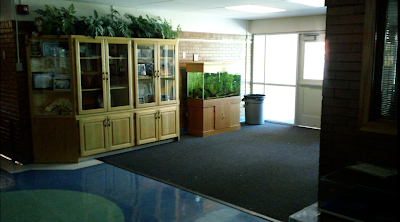Armstrong's Life Commemorated
The Colors paraded at the Armstrong memorial gathering.
On September 13 the nation gathered together at the Washington National
Cathedral to remember our first Moonwalker. Televised on NASA TV, and
covered by Fox News (the other networks did not cover the event) the
memorial brought together fellow astronauts, family and friends, and
national leaders to remember and honor the life of one of America's
greatest heroes.
The U.S. Navy posting the colors. Armstrong was a naval aviator before joining NASA as a civilian astronaut.
The speakers at the meeting talked about Armstrong as a dedicated
engineer who loved exploring through science and adventure. They also
spoke of his love of flight, and his great ability to inspire others.
Speakers included Eugene Cernan, the last astronaut to walk on the Moon,
former Secretary of the Treasury John Snow (a close friend of
Armstrong), Administrator of NASA (and shuttle astronaut) Charlie
Bolden, and religious leaders at the Cathedral. Michael Collins, the
command module pilot of the Apollo 11 mission, led the congregation in
scripture and prayers. Jazz singer/composer DIana Krall gave a moving
rendition of "Fly me to the Moon" made famous by singer Frank Sinatra.
There was also music by the U.S. Navy band "Sea Chanters," the
Metropolitan Opera Brass, and the Cathedral Choir. It ended with a
moving eulogy by Rev. Mariann Budde.
If you have the time, it is well worth your while to watch the
proceedings at the NASA website. But be prepared to shed some tears. You
can watch it
at: http://www.nasa.gov/multimedia/videogallery/index.html?media_id=152200361
After the memorial, the Armstrong family and other officials were hosted
by the U.S. Navy on board the warship U.S.S. Phillipine Sea.
Armstrong's ashes were buried at sea by Navy custom.
Farewell, Neil Armstrong.
50 Years Ago: Kennedy's Moon Speech Remembered
"We choose to go to the Moon..."
Last week NASA celebrated a another pivotal moment in history.
In May, 1961, President Kennedy had declared to Congress that Americans
should have a goal to reach the Moon before the end of the decade. On
September 12, 1962, the president spoke to a crowd of supporters at Rice
University. HIs speech explained his guiding motives in creating a
challenge for America to reach out and explore the Moon. "We choose to
go to the Moon and do the other thing, not because it is easy but
because it is hard.." he explained. While the original goal had its
roots in the Cold War competing against the space efforts of the Soviet
Union, his speech made it clear there were even greater opportunities
for the growth of our nation, and that of the world.
To see and hear the speech, go to NASA's website at http://www.nasa.gov/topics/history/features/jfk_rice_speech_50th.html
Shuttle Carrier 747 lands at Kennedy Space Center.
Shuttle Endeavor is preparing for its last trip.
Endeavor was built after the loss of the shuttle Challenger. The shuttle program came to an end when orbiter Atlantis landed at Kennedy Space Center in July of 2011. The shuttles are being dispersed to museums around the country. Endeavor will take off tomorrow on the back of the 747 and fly to Los Angeles for transfer to the California Science Center. Liftoff expected at sunrise, with a fly-over of the space center for all the fans.
Endeavor attached to the back of the shuttle carrier 747.
Expedition 32 Change of Command Ceremony.
Yesterday the Expedition 32 mission came to an end. In an official
ceremony televised on NASA TV, Suni Williams of NASA became the new
commander of the ISS. Cosmonauts Gennady Padalkin, Sergei Revin, and
astronaut Joe Acaba boarded the Soyuz TMA-04M spacecraft and undocked
just after 7 pm.
Joe Acaba on the ground.
The crew fired the retro rockets just before 10 pm EDT and the capsule
came to a safe landing in Kazakhstan. The first section of the
Expedition 32 crew had been in space 123 days. The current Expedition 33
crew is now astronaut Suni WIlliams (commanding the mission), Japanese
astronaut Akihiko Hoshide, and cosmonaut Yuri Malenchenko. They arrived
in the station on July 17.
Akihiko posing in front of the Japan module.
After the last spacewalk covered here in August, their had been trouble
with some bolts which prevented completion of some tasks. Another
spacewalk was made (making three for the Expedition) to repair the bolts
and complete the spacewalk tasks. To help her out, Suni Williams made a
special tool to help her remove debris from the bolts, using her
toothbrush (don't worry, she had another).
NASA"s latest hi-tech tool.
Showing the creative mind that astronauts are known for, the tool worked
perfectly, the bolts were replaced, and the remaining tasks completed.
Can't do that sort of work with a robot. The current three-person crew
now awaits their reinforcements. Part two of Expedition 33 will arrive
in October.

















